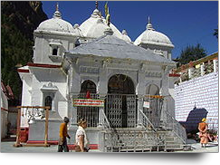
The revered shrine of Gangotri, situated at an altitude of 3,200 mts. about sea-level amidst sylvan surroundings, constitutes one of the most important pilgrimages for the devout Hindu.
The Gangotri temple was constructed in the early 18th century by a Gorkha Commander Amar Sigh Thapa. The existing temple is said to be the one reconstructed by the Jaipur dynasty. Every year thousands of pilgrims through the sacred shrine between May & October. The Pujaris & brahmins are from the village of Mukhwa. The water from Gangotri is carried to offer to Lord Shiva. It is believed that this water has amrit (nectar) in it and will soothe the throat of Shiva who gulp the poison.
Gangotri Temple Guide
The Shrine of Gangotri opens during the last week of April or the first week of May, on the auspicious day of Akshaya Tritiya. The temples opening is preceded by a special Puja of Ganga both inside the temple as well as on the river bank. The temple closes on the day of Diwali followed by a formal closing ceremony amidst a row of oil lamps. It is believed that the Goddess retreats to Mukhwa, her winter abode (12 km downstream).
In summer, Gangotri Temple is open for devotees from 6:15 am to 2 pm and 3 pm to 9:30 pm,
As winter approaches the Gangotri Temple open from 6:45 am to 2 pm and 3 pm to 7 pm.
Mangalaarti is done by priests at 6 am behind the closed doors and it is not open for public. Sandhya Aarti is performed atGangotri at 7:45 pm during summer and at 7 pm as winter approaches. Special pooja is done on Janamshtami, Vijaydashmi and Diwali.
Gangotri in Winter :
It is believed that the Goddess retreats to Mukhwa, her winter abode (12 km downstream) Mangalaarti is done by priests at 6 am behind the closed doors and it is not open for public. Sandhya Aarti is performed at Gangotri at 7:45 pm during summer and at 7 pm as winter approaches. Special pooja is done on Janamshtami, Vijaydashmi and Diwali
Nearby Places :
Bhagirath Shila:
Near the temple is a great stone slab-the ‘Bhagirath Shila’ dedicated to Bhagirath, whose penance is believed to have brought the Ganga down from the heavens.
Gomukh:
Gomukh(4200 meters), the identified source of the holy river Ganga, is 18 kms. further uphill from Gangotri. The trek to Gomukh is gradual and several pilgrims undertake the journey to pay homage the river at its known source.
Furhter downstream,10 km from Gangotri, is the picturesque forested halting place of Bhaironghati. There exists a small temple of Bhairon, appointed by Shiva to safeguard this region which gives the place its name. The bridge over the Jhanvi river at Bhaironghati is said to be the highest in Asia.
